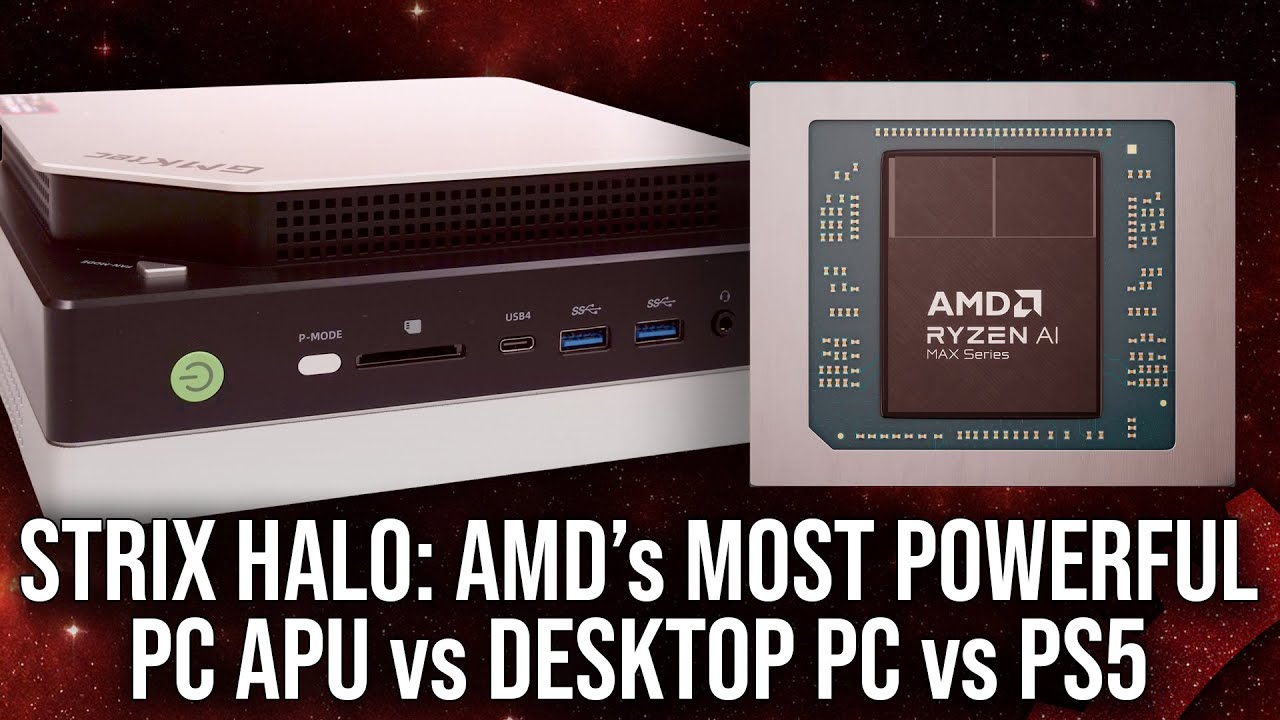The GMK Tech Evo X2 mini PC, powered by AMD’s Ryzen AI Max Plus 395 Strix Halo APU, delivers impressive desktop-class CPU and GPU performance in a compact form factor, rivaling high-end processors and outperforming several discrete GPUs while offering flexible power modes and extensive VRAM allocation. Despite some noise and cooling challenges at higher power levels, it provides a compelling, efficient gaming and AI workload solution that matches or exceeds PlayStation 5 performance in many scenarios.
The video reviews the GMK Tech Evo X2 mini PC, which features AMD’s most powerful APU to date, the Ryzen AI Max Plus 395, codenamed Strix Halo. This APU boasts an impressive 16 cores and 32 threads across two desktop-grade Zen 5 CCDs, a large RDNA 3.5 GPU with 40 compute units, and an XDNA2 AI accelerator, all fabricated on TSMC’s 4nm process. The Evo X2 is compact, smaller than an Xbox Series S, with a variety of I/O options and configurable power modes ranging from 54W silent to 120W performance. The system allows users to allocate up to 96GB of LPDDR5X memory as VRAM, supporting high-end gaming and AI workloads, though it can get noisy under heavy load.
CPU performance of the Strix Halo APU is notable, rivaling desktop processors like the Ryzen 9 9900X and Intel’s Core i7 14700K in multi-threaded tasks such as Cinebench and video encoding. Despite being a mini PC with a capped TDP of 120W, it delivers strong results thanks to its 16 Zen 5 cores with full 512-bit floating-point units. However, shared memory bandwidth between CPU and GPU can impact mixed workloads, and the APU lacks the large cache advantages found in some desktop CPUs, slightly limiting peak performance in certain scenarios.
Gaming performance was tested across various power modes, with 54W identified as the optimal balance between power consumption and frame rates. Higher power modes (85W and 120W) provide diminishing returns in performance relative to the increased power draw, making the balanced mode the best choice for most users. The integrated RDNA 3.5 GPU in Strix Halo delivers desktop-class graphics performance, outperforming several Nvidia and AMD discrete GPUs like the RTX 3060 and RX 6600 in many titles, though it falls short of higher-end cards like the RTX 5060. Ray tracing performance is solid but generally favors Nvidia GPUs.
When compared directly to the PlayStation 5, the Strix Halo APU in the GMK Tech Evo X2 holds its own impressively. Despite the PS5’s advantage in memory bandwidth and power draw, the mini PC matches or slightly exceeds PS5 performance in several multiplatform games at similar settings. The APU’s Zen 5 CPU cores offer a 25% performance improvement over the PS5’s Zen 2 cores in CPU-bound scenarios, though some games show only modest gains due to shared bandwidth constraints. Power consumption of the Evo X2 system is lower than the PS5, making it a more efficient option for similar gaming performance.
In conclusion, the AMD Ryzen AI Max Plus 395 APU and GMK Tech Evo X2 mini PC deliver remarkable performance for their size and power envelope, especially in gaming and AI workloads. The ability to allocate large amounts of VRAM and the strong CPU and GPU performance make it a compelling choice for portable and compact gaming devices, including upcoming handhelds and tablets. While the system faces cooling and noise challenges at high power levels, it represents a significant step forward in mobile APU design, potentially offering a portable gaming experience close to that of a PlayStation 5.
